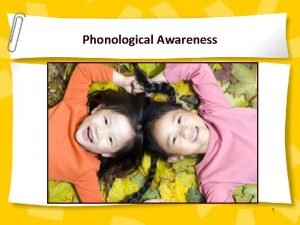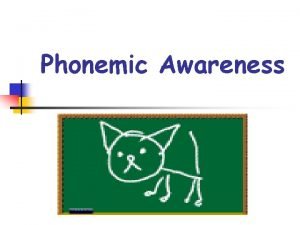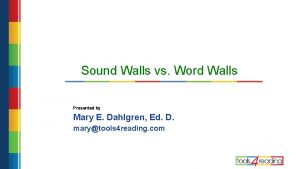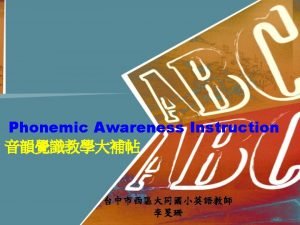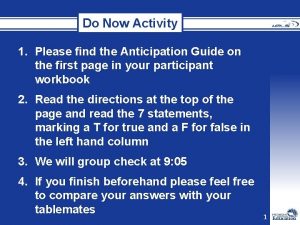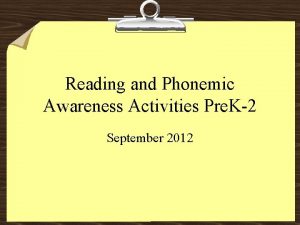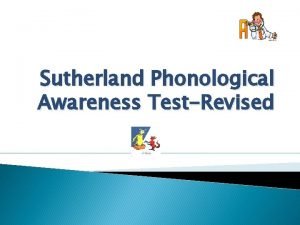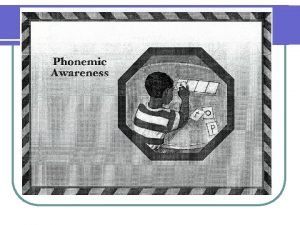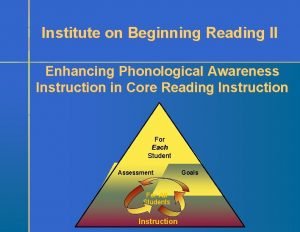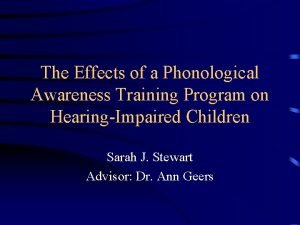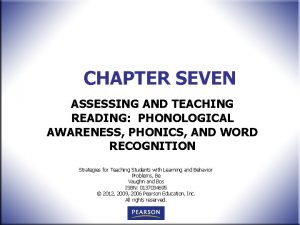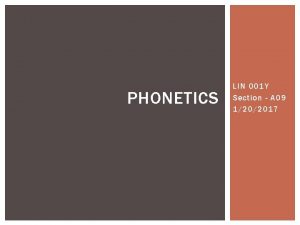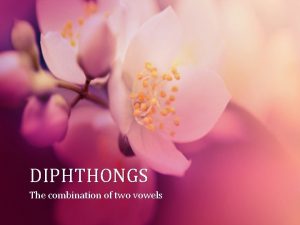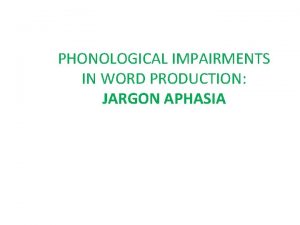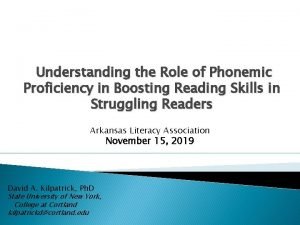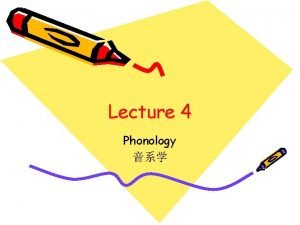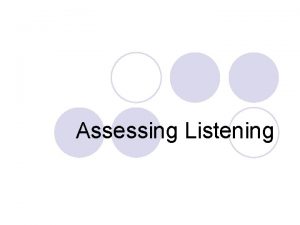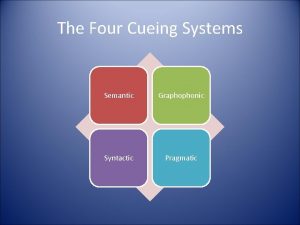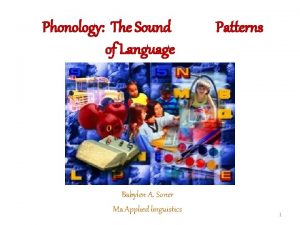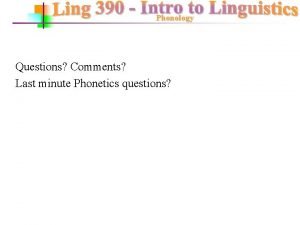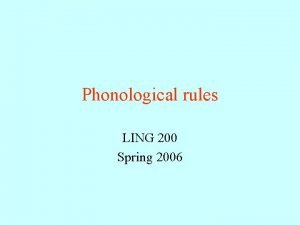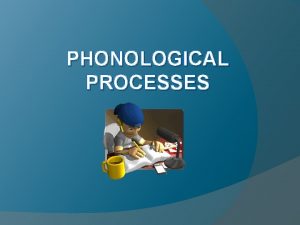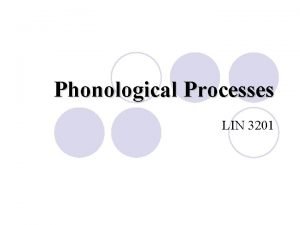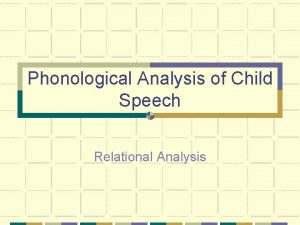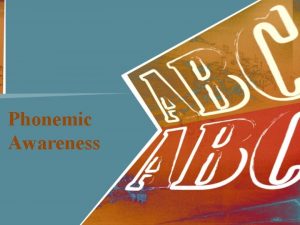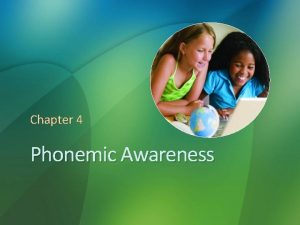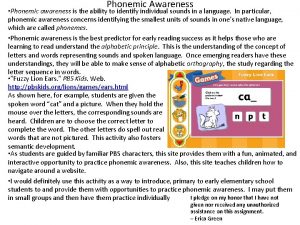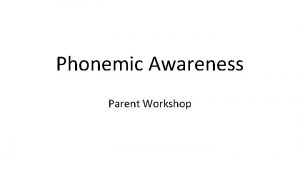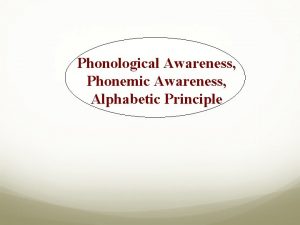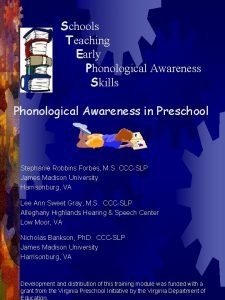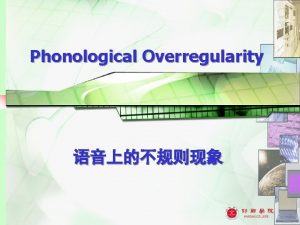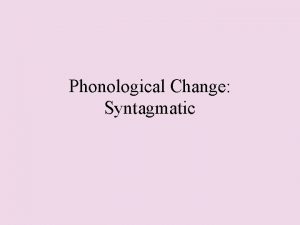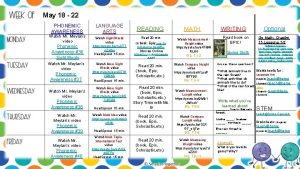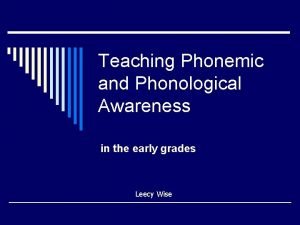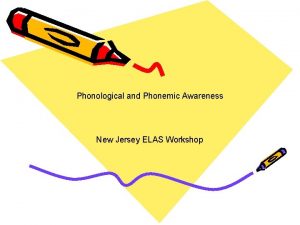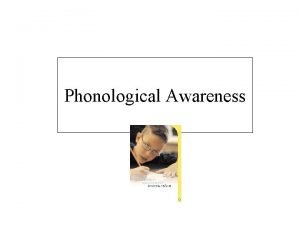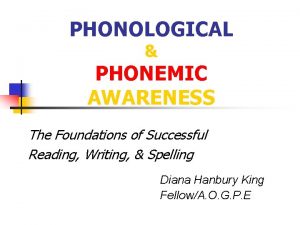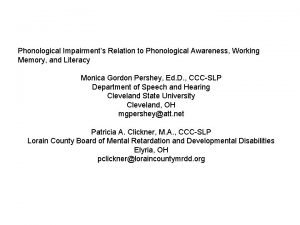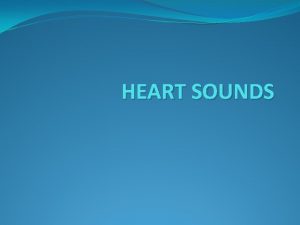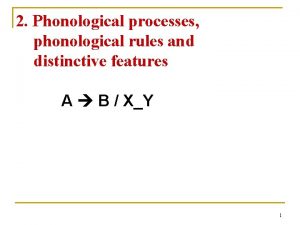Sounds Phonological and Phonemic Awareness Chapter 6 Common

































- Slides: 33

Sounds! Phonological and Phonemic Awareness Chapter 6

Common Sounds _______: smallest units of speech that serve to distinguish one utterance from another in a language Common vowel sounds are _______ sounds. These are hard to master because they are easily confused USE _______ TO TEACH (next page) l May have some vowels that you change due to regional accent (e. g. , dog=dawg; still=steel; on=own; tree) l

a apple Vowel Cues e o elf i u octopus itch up

Continuous vs Stop Sounds ________ sounds: sounds that can be said for several seconds without distorting the sound _____ sounds: sounds that can only be said for an instant

PRACTICE SOUND PRODUCTION!!!!

Phonological & Phonemic Awareness _______ awareness: Awareness of the larger parts of spoken language as well as awareness of the smaller parts (e. g. , words, syllables, sounds) Phonemic Awareness: Awareness of ______ (i. e. , sounds) PHONEMIC ASWARENESS IS A SUBCATEGORY OF PHONOLOGICAL AWARENESS

Instruction Begin with the most basic level and proceed forward Teach __________ rather than implicitly Goal: prepare student for decoding and encoding instruction The following instructional sequence indicates which skills should be taught PRIOR to, or along with, beginning decoding instruction.

Levels 1 & 2 of Phonological Awareness Level 1: ______ 1. Counting words in a sentence 2. Recognizing same/different words 3. Recognizing rhyme 4. Completing or producing rhyme Level 2: _________

Levels 3 & 4 Level 3: _________ 1. Blending syllables to form words 2. Segmenting words into syllables 3. Deleting syllables from words Level 4: Phoneme Level = ___________ 1. Blend onset and rime 2. Blend phonemes into words 3. Segment words into phonemes 4. Add phoneme to word, delete phoneme from a word, change a phoneme within a word

Level 1: Word 1. Counting words in a sentence “The dog ran. ” “The dog ran down the street. ” (counters) Variation: _____________ T: The dog ran down the street. Say that. (S responds) T: Now, say part. (S may respond, “The dog ran down. ” T: The dog ran down. Say part of that. ” (S: “The dog ran” T: The dog ran. Say part of that. (S: “The”)

Another variation at the sentence level is Word Chairs Have students put four chairs in a row l Read a sentence (e. g. , We see the cow. ) S repeat. l Choose 1 student to represent each word in the sentence l The four students stand in order in front of the chairs l Lightly touch the head of each student, saying the word he/she represents (you model) l Lightly touch the head of each student as ALL students say the word that each student represents. l Have the 4 th student to sit down. Lightly touch the heads of the students have all the students say the word that each student represents. (We see the) l Follow this process until only the 1 st student is standing l

Level 1: Word 2. Recognizing same/different words T: Look at these 2 things. They are the same. They are both circles. Using your finger, trace the circle. These 2 things are the same. Can you feel how they are the same? Your finger goes around the circle. These 2 things are the same. What are these two things? They are the _____.

T: Look a these 2 things. They are different. One is a circle and one is a star with five points. Use your finger and trace the circle. Your finger goes around. Use your finger and trace the star. Your finger goes up and down, out and in. These things are different. What are these 2 things? They are _____. ”

Level 1: Word 3. Recognizing rhyme Hey, They Rhyme. Read a short rhyme, emphasizing rhyming words. Ex. The lazy cat sat on a mat. Hey, cat, mat rhyme. What words rhyme? The silly old goat slept on a coat. Hey, goat, coat rhyme. What words rhyme?

________ T: I will say 3 words. You say the words after me. Two words rhyme and one does not. Tell me which one does not rhyme. mat, cup, rat lap, cap, mug mop, fit, hit

Level 1: Word 4. Completing or producing rhyme Oops! Wrong rhyme! Oops! I mean this is my ______. ” ______ and ____ rhyme. ” T: [Points to head] This is my red. T: Oops! I mean this is my ______. ” S: (fill in the appropriate rhyme) T: Head and red rhyme.

Level 2: Discrimination of Sounds Again, start with the most simple task. Have students say the sound /m/ while looking in the mirror. Say, “Are your lips together? Can you see your lips together? Can you feel your lips together? ” Now have students say /s/ while looking in the mirror. Say, “Are your teeth together? Can you see your teeth together? Can you feel your teeth together? T: I am going to say some sounds. Watch my mouth as I saw them. If my mouth looks the same, point to the same card. If my mouth looks different, point to the different card. /m/; /s/; /m/ /s/; /s/ /m/; /m/ /m/; /s/ /m/

Level 3: _______ 1. Blending syllables to form words _________ T: Basket (pause) ball. I can say it fast. Basketball. My turn again. Play (pause) ground. I can say it fast. Playground. (modeling) Do it with me (modeling). Ice (pause) cream. Let’s say it fast (guided practice). Rain (pause) bow. Let’s say it fast. Now, it is your turn. Pop (pause) corn. Say it fast.

Level 3: Syllable 2. Segmenting words into syllables T: We are going to learn to clap out syllables. My turn. April (2 claps). My turn again. Kenyatta (3 claps). (modeling) T: Your turn to do it with me. Nakia. Say it and clap it.

Level 3: Syllable 3. Deleting syllables from words What’s Left? T: Sunset. Say that. T: Say it again but don’t say set. pancake, rainbow, Sunday, beside, rabbit, sidewalk, cartoon, winter

Level 4: Phoneme Level = PHONEMIC AWARENESS 1. Blend onset and rime Blend: beginning consonant(s) before the vowel(s) Rime: includes the vowel and letters to the end of the word

Level 4: PHONEMIC AWARENESS 2. Blend phonemes into words ___________

Level 4: PHONEMIC AWARENESS 3. Segment words into phonemes 8 ☼ T: Look at the pictures. Each word pictured has the same number of sounds as the number of squares under it. As you say each sound, move a counter under each picture. T: Now, say the word.

Level 4: PHONEMIC AWARENESS 4. Add phoneme to word, delete phoneme from a word, change a phoneme within a word Add phoneme: T: at S: at T: say it again but put a /s/ at the beginning. S: sat Delete phoneme: T: slip S: slip T: say it again without /s/. S: lip Change phoneme: T: log S: log T: change the /l/ to /d/. S: dog

Activities Catts, H. , & Olsen, T. (1993). Sounds abound; Listening, rhyming, and reading. East Moline, IL: Lingui. Systems. Neuhaus Education Center. (2002). Reading readiness. Houston, TX: Neuhaus Education Center.

Phonemic Awareness & Reading Phonemic awareness skills typically develop slowly during _____ and ________ but are usually not fully developed until after students learn to read (grades 1 & 2) There is a _____ relationship between phonemic awareness skills and reading.

Telescoping and Segmenting Functions 1) Helps students hear different sounds 2) Gives students practice in saying sounds in words slowly without pausing 3) Gives students practice in saying letter sounds

Format for Telescoping Sounds Listen. We are going to play a say-the-wordgame. I’ll say a word slowly, then you say the word fast. Listen. (Pause. ) iiiiiiffffff. What word? (Signal. ) Repeat step 2 with 4 more words: sat, Sid, am, fit. Repeat set until students can respond correctly to all of the words, making no errors. Teacher gives individual turns.

Error Correction for Telescoping Student makes the mistake. (Teacher says ssssiiiiid and student says sad. ) Teacher says the correct answer. Teacher then _______ the task. My turn. SSSSiiiid. What word? Sid. Teacher then ______. Teacher and student respond together. “Ssssiiiiid. What word? (Signal. ) Sid. Teacher _____ and only student responds. Your turn. SSSSiiiid. What word? Return to 1 st word in list. Let’s see if we can do all the words without making any mistakes.

Segmenting We’re gong to say words slowly. First word. Sad. I’ll say it slowly. Listen. SSSSSaaaad. You say it slowly. Get ready. (Signal for each sound. ) Repeat the step with me, and fit. Repeat the set of words until students can say every word slowly, making no errors. Give individual turns to students.

Error Correction for Segmenting Stop the student immediately. _____ the correct response. _____ the student in making the response. ____ the student.

Instruction of Telescoping and Segmenting _______: Watch mouths as students make responses & also watch eyes because eyes should be focused on teacher’s mouth ______: Move quickly between words: NOT A LOT OF VERBAGE; brisk pace keeps students on task: no down time _______: select regular words that students will see in early word reading tasks (VC, CVC)

Direct Instruction Rhyming Format m s f • Listen. I’m going to rhyme with at. What am I going to rhyme with? (Signal) • Teacher puts finger on ball of first arrow and says: My turn. Rhymes with at. Teacher moves finger across arrow and says mat. • Teacher repeats step 2 with remaining arrows. • Teacher puts finger on ball of first arrow and says: You’re going to rhyme with at. What are you going to rhyme with? (Signal) Rhyme with at. Teacher moves finger across arrow.
 Phonological awareness continuum chart
Phonological awareness continuum chart Phonemic awareness definition
Phonemic awareness definition Prephonemic stage
Prephonemic stage Phonemic awareness flashcards
Phonemic awareness flashcards Mary dahlgren sound walls
Mary dahlgren sound walls Phonemic awareness ppt
Phonemic awareness ppt Phonemic awareness
Phonemic awareness Phonemic awareness
Phonemic awareness Phonemic awareness, sioux falls
Phonemic awareness, sioux falls Phoneme identity activities
Phoneme identity activities Sutherland phonological awareness test
Sutherland phonological awareness test Phonological continuum
Phonological continuum Phonological awareness skills from easiest to hardest
Phonological awareness skills from easiest to hardest Phonological awareness training program
Phonological awareness training program Phonological awareness ppt
Phonological awareness ppt Phonological awareness
Phonological awareness Oral sounds and nasal sounds
Oral sounds and nasal sounds Cvs privacy awareness and hipaa training answers
Cvs privacy awareness and hipaa training answers Diphthong vowels examples
Diphthong vowels examples Study of speech sounds
Study of speech sounds Phonemic jargon
Phonemic jargon Phonemic proficiency
Phonemic proficiency Phonemic transcription
Phonemic transcription Listening answer
Listening answer Examples of phonological ambiguity
Examples of phonological ambiguity Graphonic cue
Graphonic cue Central executive
Central executive Phonological loop
Phonological loop Syllable structure examples
Syllable structure examples Difference between phonetics and phonology
Difference between phonetics and phonology Phonological rule
Phonological rule Linking vowel to vowel examples
Linking vowel to vowel examples Vowel phonological processes
Vowel phonological processes Phonological process analysis
Phonological process analysis
